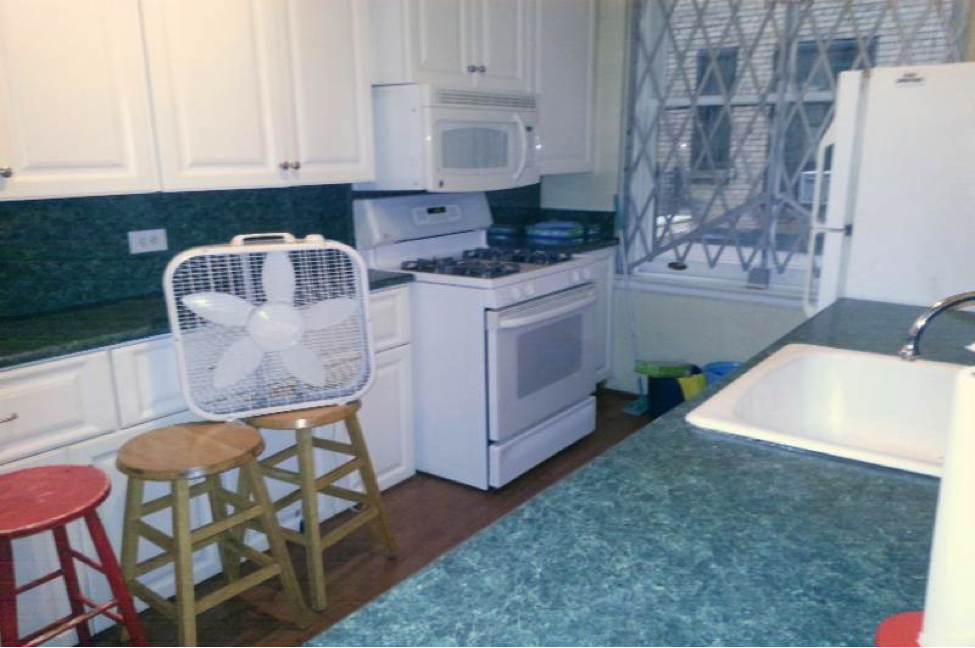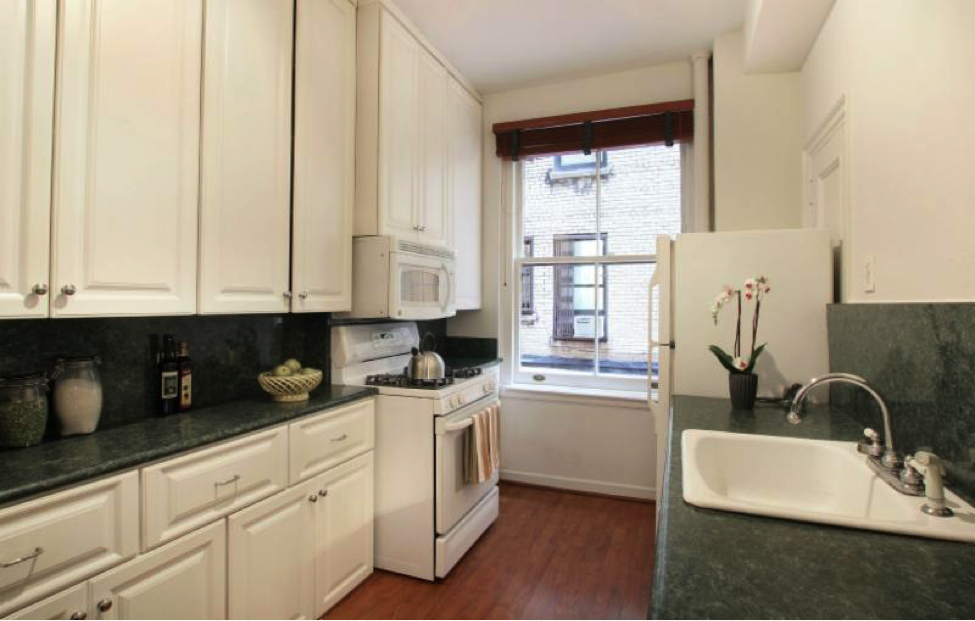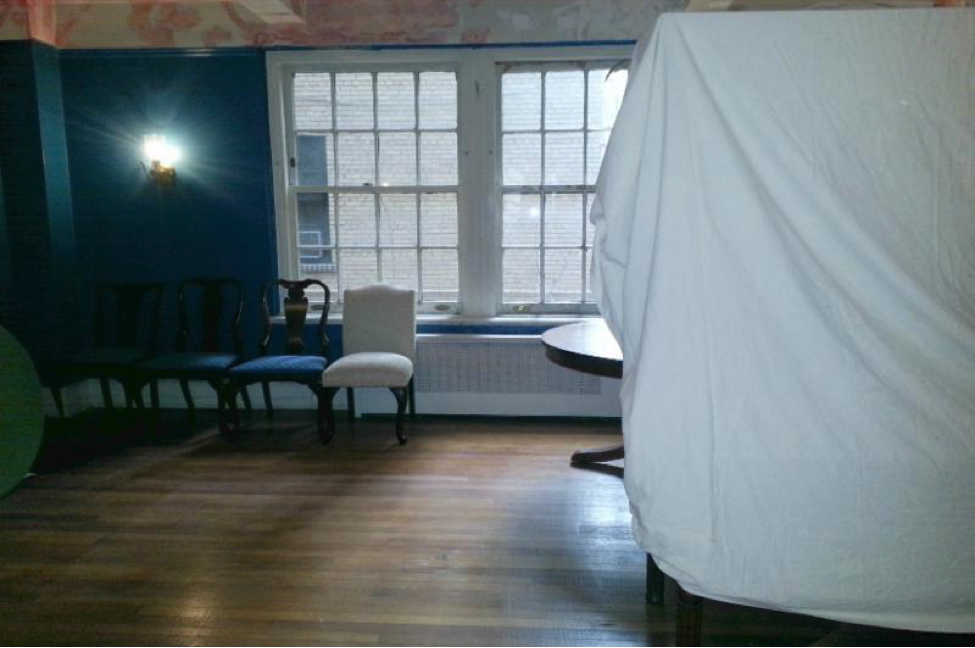At CES 2015: More Attempts to Dethrone Stainless Steel’s Popularity
By Melissa Dittmann Tracey, REALTOR® Magazine
Stainless steel’s popularity has outshined its competition for years in kitchen appliances, but has that shiny, smudge-prone finish finally worn out its welcome?
Appliance manufacturers have long been trying to find a potential successor to stainless steel, but none have yet to find one to top its popularity. But two companies are giving it another chance with showcases at the 2015 Consumer Electronic Show in Las Vegas this week.
Appliance giant Whirlpool and LG are showing off new appliance finishes — with Whirlpool betting on gold and LG debuting a glassy black.
Whirlpool is introducing Sunset Bronze appliances to its lineup — a range of warm, golden hue appliances that can fit into contemporary or existing kitchens. The color is an attempt to capture on the latest popularity of rose gold in interior decors. It’s not a complete verge from the stainless steel look, however. Sunset Bronze is a painted version of traditional stainless steel with a blend of gold, copper, and bronze tones.
Meanwhile, LG is showing off a new take on black finishes. At CES this week, LG debuts a glass-front refrigerator finish called Contour Glass. The refrigerator features tempered glass over a black patterned finish that is a chic, yet smudge-proof way, to enhance kitchens. The finish is featured on LG’s new door-in-door refrigerators, which offer hidden compartments for extra storage behind the front door to hold condiments and drinks.
Will these smudge-proof finishes offer a convincing enough, stylish alternative to stainless?
“The kitchen is fast becoming a new canvas when it comes to home design and décor,” says John Hall, senior brand manager at Whirlpool. “More and more, consumers seek ways to customize their spaces with new paint colors, different countertops and backsplashes, mixing and matching cabinetry, and colored small appliances.”
In 2012, Whirlpool had introduced White Ice and Black Ice finishes to its products lineup in its first attempt to to provide an alternative to stainless’ popularity. The color failed to catch on, though. Other manufacturers have tried as well, such as General Electric’s low-gloss slate gray finish. (Read our previous blog post on the topic: Will Stainless Steel’s Popularity Ever be Dethroned?)
What do you think? Do you think stainless steel stands a chance of being outshined in the kitchen any time soon?
Source - Realtor.org
5 Simple Life Hacks to Boost Experience
- At January 5, 2024
- By Mark Anton
- In Real Estate News
By Sam DeBord
Real estate rookies can really kick start their learning experience by picking up some simple shortcuts from those who’ve been selling for many years. These are just a few of the real estate “hacks” I’ve learned over the years from seasoned practitioners that improved my experience and knowledge in simple yet effective ways.
1. Know the Concierge
Do you know every building and subdivision in your city like the back of your hand? I’ve sold all over Seattle for many years, but there are more than 1,000 condo buildings in the metro area. You can’t possibly know them all well.
If you’re going to show a buyer a condo in a building where you’re not an expert, get a boost for your experience and your image by previewing or showing up 30 minutes early to talk to the concierge. Find out where the amenities are and tour the unit, but also get the concierge’s name. When your client arrives, you can stroll in together and greet the concierge with, “Hi Tony, good to see you again, we’re headed up to see the pool.” You’ve already done the research to be prepared for your client, so you might as well add that splash of “in-the-know” to your appearance.
Of course, the same applies to knowing the security guard at a gated community, the marina manager at a houseboat community, or any other gatekeeper to a property you intend to show.
2. Point Out the Negatives Right Away
Consumers who don’t know us aren’t sure they can fully trust us at first. With new clients, they may be concerned that your goal is to sell them whichever home you can get them into as quickly as possible.
Show them that you’re a trustworthy source of information by not focusing solely on the positive selling aspects of a home, especially at your initial meetings. By pointing out the drawbacks of the home they’re touring right away, they’ll develop trust for your opinions and realize you’re not all about the sale.
I’ve had numerous clients thank me after our very first showing, because I started out with an analysis of the home’s weaknesses instead of a sales pitch. Have you ever pointed out that “ocean breeze” sound that you can hear from the master bedroom (freeway noise)? They love it. If you let clients understand upfront that you’re there to help them buy a home, as opposed to sell them a home, they will have have long-term loyalty.
3. Keys in the Back Pocket
This one is a bit silly, but still practical. Have you ever arrived at the fifth house on an eight home tour and found an extra set of house keys in your possession? Buyer tours can be complex, and sometimes agents make the mistake of setting keys down or putting them away quickly when they’re trying to pay attention to their clients. It rarely happens, but when it does it’s an embarrassing and time consuming mistake.
You’ll probably never drive away with someone else’s keys if they’re in your back pocket and you have to sit on them. Even better, put the whole key compartment from the keybox in your back pocket if it fits. It will be a constant reminder that the house isn’t secure until you’ve put it back, and even the most distracted agent won’t be able to sit on it and drive away (apologies to those whose fashion style doesn’t permit the use of pockets).
4. Spend Time Investing in Your Local REALTOR® Board
Think you know what’s happening in your local real estate market? Working with buyers and sellers is just the tip of the iceberg. Listen in on a meeting of your local board’s government affairs, business practices, or MLS issues meetings. You’ll realize how much more is going on behind the scenes.
Understanding the big picture issues of real estate that your REALTOR® board is dealing with every day will build your knowledge quickly. Joining a committee can give you the extra confidence and subject material to discuss these kinds of topics with clients. You can show them that you have unique industry knowledge as well as the ability to sell their homes.
Consumers view any management title you hold with your REALTOR® board as a sign that you’re a leader in the community, and you can climb that ladder quickly if you’re willing to put in the time.
5. Suit Up
Appropriate business attire can vary widely in real estate. If you’re comfortable and successful in your business already, you can wear whatever you like. If you’re newer to the business and hoping to look more experienced, though, don’t give in to the ego trip that says, “I’m going to look how I always look and people can take me for who I am.” This isn’t your high school drama club, it’s a tough business where the majority of agents aren’t particularly successful. Consumers want to play with a winner, and if you look and act like someone who is successful, they will be more inclined to believe you are.
If you know that your image will improve with more professional business attire, then buck up and wear it like your income depends on it–because it does. This doesn’t mean you need to go buy the latest sports car and Armani suit. Just don’t give in to the laziness that says, “I’ll clean out my car next week,” or “I don’t feel like putting on a jacket today.” To this day I wear a suit to every initial meeting with a client, no matter their age or style. You’re always safer overdressed than underdressed.
Sam DeBord is managing broker of Seattle Homes Group with Coldwell Banker Danforth, and a state director for Washington REALTORS®. You can find his team at SeattleHome.com and SeattleCondo.com.
![]()
Source - Realtor.org
Reveal to Your Clients the ‘Ugly Truths’ When Staging
- At January 5, 2024
- By Homes for Sale
- In Real Estate News
By Audra Slinkey, Home Staging Resource
Sometimes you have to give clients a big dose of reality, and it isn’t always pretty – particularly when you’re talking about something personal like the condition of their home. But don’t be afraid to utter the “ugly truths” to maximize your sellers’ chances of selling a home and for top dollar.
Here are some of the ugly truths you may need to be prepared to talk about:
Ugly Truth #1: The ugly truth is that anyone who has watched the real estate market over the last few years knows there’s no such thing as a “set price” for a home. The price is determined by what the buyer is willing to pay AND the buyer likely is willing to pay a lot more for a “model home” look.
Ugly Truth #2: Another ugly truth is that when it comes to home staging, you get what you pay for. This means that the more a seller is willing to pay to transform their home (using an expert stager’s advice), the more they stand to get out of the sale.
Ugly Truth #3: Finally, the last ugly truth is that buyers cannot see past a seller’s furnishings to the potential of the home. Look at the before photo …would you be able to imagine it as beautiful as the after photos?
You only need to look at the before-and-after photos of this home to know why they got so much more than they were even asking. This seller’s agent walked them through the “cost of not staging” and let them decide. Do you think they made the right decision?
If you’re a real estate agent who struggles with getting your seller’s onboard and committed to the sales process, you may want to share with them this article … pictures always speak louder than words.
 ABOUT THE AUTHOR: Audra Slinkey is president of the Home Staging Resource, a RESA Accredited home staging training and certification company. Slinkey has personally trained over 3,000 stagers worldwide and is a bestselling author and international speaker. She also serves as president of the American Society of Home Stagers and Redesigners. Connect with her on Facebook!
ABOUT THE AUTHOR: Audra Slinkey is president of the Home Staging Resource, a RESA Accredited home staging training and certification company. Slinkey has personally trained over 3,000 stagers worldwide and is a bestselling author and international speaker. She also serves as president of the American Society of Home Stagers and Redesigners. Connect with her on Facebook!
Source - Realtor.org
What Being a Leader Really Means
- At January 2, 2024
- By Mark Anton
- In Real Estate News
By Wade Corbett
Over this past year I have had the amazing privilege and fortune to participate in the North Carolina Association of REALTORS® Leadership Academy. I have reflected over months on the true meaning of leadership and honestly, I have yet to come up with a definitive description. I cannot say what being a leader is, but I can say without a doubt what being a leader is not.
Being a leader is not about you. Those who become leaders because of a desire for glory or for public recognition are not true leaders. These are the types of people who will stop leading when it stops being convenient. As past NAR President Charles McMillian taught me earlier this year, being a leader is not always convenient. Leading your association, community, church, family, etc. is not easy and it doesn’t always fit into your planned schedule. Sometimes you may have hardships in your life while also having to lead.
Being a leader is not about being at the top of the pyramid. This is something I never comprehended until this year, but some of the best leaders are those who never rise to the highest position of power. I have always had a “rise-to-the-top” personality. But I now understand that me being at the top is not always what’s best for the organization I’m involved in. I learned from the eleven other people in my leadership class (The Best Class Ever) that we are all different types of leaders. There is a time to lead and there is a time to follow other leaders. Following does not mean that you’re subservient to anyone. It only means that you lead from below and help those who happen to be at the top.
Being a leader is not about building on your accomplishments, but contributing to the cause. Kim Dawson, NCAR’s president-elect, taught me that we are each just one piece of a much larger puzzle. Many people believe they are the whole puzzle and that being a leader in an organization is a piece of their puzzle. You are only one piece of the puzzle in the organization you are leading. If you do not have this mind-set, sit back and ask yourself: Why am I a leader?
As REALTORS®, there are a lot of changes facing us on the horizon, particularly NAR’s new Core Standards taking effect in 2015. You need to step up at your local, state, and national association to become part of the leaders of tomorrow. Join your local YPN and volunteer for association committees. Who knows; maybe you’ll become the president of NAR one day! Not that that’s what leadership is about. But it is fun thing to dream about!
If you have any questions about how to get involved in on the local, state or national level, please email me directly at [email protected].
Wade Corbett is a REALTOR® with RE/MAX Southland Realty in Garner, North Carolina. Connect with him at WadeCorbett.com or facebook.com/WadeCorbettInc.
![]()
Source - Realtor.org
Real Estate Resolutions for 2015
- At December 30, 2023
- By Mark Anton
- In Real Estate News
By Elizabeth Mackay
Do you still make New Year’s resolutions? Do you still hold the hope of something better, something more, as you leave one year behind and embark on another? It’s easy to feel hopeless, there are the old year’s resolutions unmet and the gaping question of whether you’ll see the new year, much less live it out. Yet, progress is the basis of humanity. It is our natural state to want more, to aspire to something greater. Besides, what is life if not lived with hope for better days ahead?
So in the spirit of hope, here are my real estate resolutions for the new year.
I will embody temperance. No more will I be tossed about by the the fierce storm of real estate ups and downs, successes and failures. Like life, real estate is a game and I will play to win. But win or lose, I will embody temperance. I will accept both outcomes in the spirit of growth. I will call on humility in times of triumph, and perseverance in times of failure; for all failure is temporary – if we do not quit!
I will never give in. Never! When I feel defeated and small, I will listen to the words of Winston Churchill and I will stand tall. “Never give in, never give in, never, never, never, in nothing great or small, large or petty. Never give in except to convictions of honour and good sense. Never yield to force. Never yield to the apparently overwhelming might of the enemy.” I will not give in to defeat, to fear, or to doubt; I will never give in to the ruthlessness or insincerity of others. I will not give in even to my own limitations.
I will forgive. I will forgive myself for the mistakes of yesterday and I will forgive others for theirs. I will forgive and move on in the assurance that no one can take my good away, and that all men are perfect on their own plane. I will forgive because, “I will permit no man [...] to narrow and degrade my soul by making me hate him.” (Booker T. Washington)
I will guard my self respect. I will erect my personal boundaries and cross them not for man or fortune. “For what shall it profit a man if gain the whole world and lose his own soul?” (Mark 8:36, KJV). Whatever the road I take in life, I will walk my own way and let the crossroads be navigated according to what I hold dear and true. I will step forward in confidence and keep moving until the fluttering subsides. I will believe in myself!
I will take the hard road. I will labour at my craft, I will learn and apply the tools of my profession, and I will succeed. Where others falter I will endure. I will not give in to fatigue and desperation. When I am tempted to submit, I will remember the words of Longfellow and I will work harder. For, “The heights by great men, reached and kept, where not attained by sudden flight, but they, while their companions slept, were toiling upward in the night.” I will persist and I will win.
I will stay in faith. When all else fails and I lose my temper and harbour animosity, when I temporally give in to the vagrancies of real estate, when I lose hope and succumb to despair, I will hold on to faith. I will lift myself up and try again and again. When another year ends and a new one approaches and I find unmet goals and botched resolutions, I will make new resolutions and start all over again in renewed faith that better is before me, and that perhaps the glory is in how we walk our path rather than where we ultimately end up.
I’d love to hear your resolutions. Please feel free and brave and share them with me in the comments below. Together we’ll stand on this point in space and declare ourselves great!
Wishing you a new year filled with wonder and delight!
Elizabeth Mackay, MBA, is a salesperson with CA Christie Real Estate in The Bahamas. Connect with Mackay at livelifebahamas.com or [email protected].
![]()
Source - Realtor.org
3 Ways to Start a Bidding War Through Staging
- At December 29, 2023
- By Homes for Sale
- In Real Estate News
By Audra Slinkey, Home Staging Resource
Every real estate professional wants to have the reputation for being “the agent that makes the most money for their sellers.” But how exactly can you do that? First, I’m going to give you a real life example of a home that recently sold for $100,000 over asking price, and then I’m going to provide the three ways this stager and agent got a bidding war started while we view the before-and-after photos from Donna Dazzo of Designed to Appeal.
1. Assess the home’s market potential
Every real estate agent understands the various factors that come into play to determine the “comparables” for a property, but when a property is upwards of $200,000, there is a larger “staging potential” that comes into play. Recently, 2014 staging statistics show that professionally staged homes on average sell 10 percent higher than non-professionally staged homes. So what is that 10 percent worth to your seller?
For instance, in the above photo the agent would have an idea of the asking price of this home in it’s current “unstaged” condition. But what about in its staged condition…
As you can see, the marketing of the home in both staging and photos has a dramatic effect on the outcome of the sales price. I call this the “buyer desirability factor” because the stager pinpoints the type of buyer we want and raises the “desire” for the space.
How can you assess the home’s market potential? First you need to assess the reasonable sales price of the home in its unstaged condition compared to its competition. Next, you need to ask whether you may be able to raise the price of the home at least 10 percent in its staged condition. If that raised sales price is over $10,000 …
2. Coax seller “buy-in”
One of the biggest challenges for agents is getting the seller to understand the need for professional staging, as well as committing them to the sales process. Ask the seller, these few questions which will get them thinking about the quality of product they are putting forth and the dollar potential they are leaving on the table in the sale of the home:
Critical Question #1: What percentage of your home has not been remodeled in the last 5 years? Even though not all remodeling projects are equal, this question speaks to the relevance of this home and the design knowledge of the home seller, since interior design styles have changed drastically in the last few years.
Critical Question #2: What percentage of your furnishings (particularly artwork) has been purchased in the last 5 years? As you can see from the before photo above (which is typical for most homes), most homes have dated furnishings which lowers the “buyers desirability factor” drastically.
Critical Question #3: If you could make 10 percent more on the sale price of your home through professional staging, can I refer an expert home stager your way? Remember, statistically sellers who have their home professionally staged are making on average 10% more in this market than those who attempt to do it themselves. Sellers rely on their agents to educate them on the sale process and what they need to do to make the best price for their home. In this market, the seller who sells quickly but makes $30,000 less than their neighbor because they didn’t stage will not be happy sellers.
3. Don’t be afraid to tell the “ugly truths.”
The ugly truth is that anyone who has watched the real estate market over the last few years knows there’s no such thing as a “set price” for a home. The price is determined by what the buyer is willing to pay AND the buyer is willing to pay a lot more for a “model home” look. Stay tuned for next week’s blog post for more of the “ugly truth’s” in staging …
 ABOUT THE AUTHOR: Audra Slinkey is president of the Home Staging Resource, a RESA Accredited home staging training and certification company. Slinkey has personally trained over 3,000 stagers worldwide and is a bestselling author and international speaker. She also serves as president of the American Society of Home Stagers and Redesigners. Connect with her on Facebook!
ABOUT THE AUTHOR: Audra Slinkey is president of the Home Staging Resource, a RESA Accredited home staging training and certification company. Slinkey has personally trained over 3,000 stagers worldwide and is a bestselling author and international speaker. She also serves as president of the American Society of Home Stagers and Redesigners. Connect with her on Facebook!
Source - Realtor.org
The Truth About Grad School
- At December 23, 2023
- By Mark Anton
- In Real Estate News
By Brittney Schwartz, REALTOR® University
Graduate school can be both an incredibly challenging and rewarding time in a person’s life. A lot of what you will ultimately take away from the experience depends upon how you approach it. Some of the best people to help you prepare are the ones who’ve already been through the process.
That’s why we spoke with current and former students of REALTOR® University’s Master of Real Estate (MRE) program to get their advice for getting the most out of your program. Their advice covers everything from self-care and finances to future goals and planning.
1. It’s a time to find your niche.
Graduate school is your opportunity to find the specific field you want to specialize in. Mentorships, internships, and a variety of curriculum will help you discover the path that’s right for you. Determine what about real estate speaks to you and pursue it.
My lifelong career has been in real estate associations, in support of real estate professionals, so the association management concentration made perfect sense for me. Unique to this program, though, is its balance between the academic and the practical. Many assignments allowed me the opportunity to not only research topics of particular relevance to my work at a real estate association, but also the opportunity to develop practical tools for use in the workplace.
—Mary Martinez, 2014 REALTOR® University MRE Graduate
2. Don’t toss your textbooks.
For many of us, those overpriced books are the first things we want to offload when the term is over. But in grad school, course materials are often the definitive (and sometimes the only) text on a specific topic.
I have kept my books—and referenced them. And a bonus tip, one of the first books a student should purchase is Publication Manual of the American Psychological Association, 6th edition. The papers are required to be written in APA format so becoming familiar with the book is essential.
—Mary Ann Sgobba, 2014 REALTOR® University MRE Graduate
3. Grad school is less like college and more like a full-time job.
Gone are the days of cramming for exams the night before. Many tests and projects in grad school require more time, attention, and a comprehensive study plan. It’s easy to let things pile up between classes, work, and personal life. Figure out how much time you need to set aside for studying each week, and commit to it.
The time management—especially at first—was an adjustment, but not an obstacle. For me, it worked best to get one to two hours in each night after dinner and then several hours Saturday morning. My suggestion to new students would be to find a routine that works for you and stick with it.
—Shannon Bodnar, 2014 REALTOR® University MRE Graduate
4. Leave your comfort zone behind.
If you want to be the best possible you that you can be—and ideally, that’s part of why you’re in graduate school—you’ll need to push your personal boundaries.
Learn from guest speakers and professors. Make friends with them. Unlike your undergrad career, many professors are willing to stay connected after the term ends because they are in your chosen industry. If you have the opportunity to talk to the brightest people in your field, don’t miss out because you “didn’t feel like going to class that week.” It’s an excuse you’ll regret.
I earned my original master’s degree in 1995—a time when the predominant option for working professionals [continuing their education] was brick-and-mortar schools, evenings, and weekends. The RU master’s program turns that option on its head. The workload and pace of the accelerated eight-week sessions was a bit more of an adjustment for me. It was difficult at the beginning. I liken the experience to working out a new muscle—painful at the beginning but as the muscle gets stronger the pain lessens. This program allowed me to fit schoolwork into my schedule, from the comfort of home, while away on business, or wherever.
—Mary Martinez, 2014 REALTOR® University MRE Graduate
5. Know Your Resources.
Find out what perks and bonuses a program offers beyond class electives. As a REALTOR® University student, the largest real estate library in the world is at your fingertips. Students receive unlimited access to the REALTOR® University Library while completing our Master of Real Estate program, and can maintain access as alumni as well.
The REALTOR® University Library staff is awesome and provides assistance with research as well as review of papers before submitting to the instructor. I would recommend that students complete their writing assignments a few days before due date to allow for review by the REALTOR® University Library staff. Besides the assistance with research, the review by the Library staff was extremely helpful.
—Mary Ann Sgobba, 2014 REALTOR® University MRE Graduate
6. Enjoy the ride.
Going back to school can be a big time and financial commitment, but it can also be an eye opening and fulfilling part of your academic career—and it opens doors you’ll appreciate for the rest of your life. Plus, you’ll learn new skills and become an expert in topics that you weren’t as knowledgeable in when you began the program. Getting an advanced degree will set the stage for your professional advancement, but it’s also a great adventure. Find ways to enjoy it every step of the way.
For more information about the Master of Real Estate program and other educational opportunities available through REALTOR® University, visit www.realtoru.com.
![]()
Source - Realtor.org
Which Color Combinations Go Well Together In Staging?
- At December 22, 2023
- By Homes for Sale
- In Real Estate News
By Lindsey Schroeder, Archway Construction
 Conventional wisdom says to paint everything white when a home is up for resale — but savvy sellers know color can actually be a smart staging tool.
Conventional wisdom says to paint everything white when a home is up for resale — but savvy sellers know color can actually be a smart staging tool.
A well-chosen color scheme in furniture and décor can do more than add appeal to rooms — it can evoke strong emotional responses. Potential buyers may find themselves drawn to a home with restful tones in the bedrooms, for example, and with unified access throughout.
Consider these tips for using color combinations in staging:
1. Keep the colors cohesive: All the rooms don’t have to match, but do try to keep a unified sense of style throughout the kitchen, bedrooms, bathrooms, and living areas. Paint the largest spaces soft, neutral hues and use accent colors in smaller spaces — with nods to bolder colors throughout. Match all the molding with a bright white color, or use complementary decorating accessories in all the main living areas in order to create an open sense of flow.
2. Use red color schemes to energize, blues to calm: Red is a bold, invigorating color best used in spaces where activity takes place — the kitchen or the dining room, for example. Blues, on the other hand, work well in spaces where buyers will want to find rest, like bedrooms and bathrooms.
3. Think green for trendy impact: Popular today as nature’s neutral, green is hot in staging because it goes with everything from bold yellows to muted grays. Use it in small doses throughout a home — think throw pillows, accent walls or artwork — to enliven drab spaces.
When staging, remember that colors create a sense of style. Choose tones that evoke the responses and feelings you’re going for — and help home buyers fall in love with a property.
How do you use color in staging to draw buyers in?
AUTHOR BIO: Lindsey Schroeder is the voice behind all social media accounts and blogs for Archway Construction, home renovators and remodelers that have served Metro-Chicago for over 27 years. She also loves working with homeowners in ensuring that their color choices compliment the overall look of their homes.
Source - Realtor.org
Scientifically Develop the Habit of Lead Generation: Part 4
- At December 18, 2023
- By Mark Anton
- In Real Estate News

Alex Cavelli
By Alex Cavelli
“Simplify”
—Henry David Thorough
Over the last few weeks, I’ve taken lessons I’ve learned from the work of willpower scientist Colin Robertson and revealed techniques to help you develop the keystone habit of lead generation. Hopefully by now you’ve experimented and found success. Here’s a review:
Part 1: “Do Not Fail” – Choosing your daily contact goal.
Part 2: “The Seinfeld Method” – Forming consistency.
Part 3: “Definite Purpose” – Envisioning your purpose.
Based on the emails I’ve received, it seems that all three parts have made an impact. A recurring question has been, “How do I find time for lead generation when I have all this other stuff going on?” The answer: simplify.
The Minimalists
One of my favorite recent stories is about young man named Ryan Nicodemus. Nicodemus, along with his friend Joshua Fields Millburn, are two 20-something Ohioans who once believed they had it all.
“A few years ago, while approaching age 30, we had achieved everything that was supposed to make us happy: great six-figure jobs, nice cars, big houses with more bedrooms than inhabitants, pointless masses of toys, scads of superfluous stuff…The truth is we weren’t successful at all. Maybe we looked successful…but we weren’t truly successful. Because even with all our stuff, we weren’t satisfied with our lives—we weren’t happy.”

©pippalou, 2014. Morguefile
Nicodemus needed to make a change to find happiness. To begin their journey, the two friends got together and started evaluating their material possessions. “Where do we start?” asked Nicodemus. Millburn then suggested an idea that changed both their lives forever: “The Packing Party.”
Nicodemus packed all of his possessions into boxes, labeled them, and stuffed them in a spare bedroom. Now these items didn’t just consist of their expensive gadgets. They packed clothes, shoes, cleaning supplies, kitchen utensils, bedding, plates, paintings, toothpaste, food – everything. It almost looked as if they were getting ready to load a moving truck. The main idea was this: over the next 21 days, Nicodemus would unpack nothing except for what he actually used. Whatever remained would then be sold, donated, or trashed.
The results may surprise you at first. Nicodemus unpacked only about 20 percent of his possessions over three weeks! In other words, nearly 80 percent of his possessions were deemed useless or non-essential. He donated clothes he didn’t wear, sold some of his electronics, and even got rid of those unopened cleaning supplies.
The aftereffects from this packing party were an even bigger surprise. Suddenly they found more time, energy and money to focus on what actually did bring them value. Life became “rich” again as they packed (and unpacked) other parts of their lives – relationships, careers, spending habits, and dieting. Today they travel the country encouraging audiences to pare down their lives and create space for things of real value.
So how did such a simple experiment reveal the root of their discontent? And what’s the relevance to your business? Let’s ask Colin Robertson, our willpower scientist.
Science
When we come up with tasks for ourselves, our brain creates an internal reminder that will nag us until we give those tasks attention. Think about that nagging feeling you get when you’re overdue to check your social media accounts. This mental nagging actually drains our willpower and diminishes our ability to focus on essential actives.
Or think about that sense of accomplishment you get when you cross something off your to-do list. Yes, that feeling can lead to other small successes. But the opposite is also true. If we fail to complete a task, feelings of discontent take form. This experience is known as the Zeigarnik Effect. To avoid this effect, we just need a packing party.
Application
As real estate business people, we’re only as effective as the quality of our schedule and our ability to follow it. If you’re ready to have a “packing party” for your schedule to make room for the essentials, they read on and follow these steps:
- Pull up your 2015 schedule and completely clear it.
- Black out your non-working days first (these are planned days off, holidays, family commitments, vacations, etc.). Now your workdays remain.
- Next, take January 5th and consider it the template for your “ideal workday”.
- Decide the start time to your ideal workday.
- Decide the end time to your ideal workday.
- In between your start and end times, time block these essential activities:
- Hitting your “do not fail” daily contact goal
- Listing appointments
- Negotiation
- Apply this schedule to the remainder of your 2015 workdays.
Use your judgment for important activities like attending team meetings, following up with sellers, preparing for appointments, and completing essential paperwork. For example, I call my sellers every Friday between noon and 1:00pm. Some agents choose Wednesdays. I also time block time for daily administrative work between 1:00pm and 2:00pm. If I have no appointments or essential admin work, I can always work on generating leads. When planning, it’ll be helpful to keep these averages in mind:
- 8 contacts = 1 hour
- Top agents prospect 3 to 4 hours per day, between 8:00am and noon, 5 days per week.
- 1 listing appointment = 1 hour
- Top agents spend 30 minutes or less on listing appointment, schedule them between 3:00pm and 7:00pm, 5 days per week.
- Negotiation = 30 minutes
- Top agents will typically negotiate before 7:30am, between 1:00pm and 2:00pm, and/or after evening appointments.
Conclusion
You still have eight working days left in 2014 to start building momentum for the new year. Just as Nicodemus and Millburn started their journey to happiness by paring down their possessions, you can also pare down your business by starting with your schedule. Not only will free up willpower to hit your daily “do not fail” goal, you’ll discover the time and energy to surpass it and list more real estate.
For other techniques and lead generation habit tools, visit and “like” this Facebook page.
Subscribe to Willpowered for daily scientific strategies to increase willpower in other areas of your life.
Alex Cavelli is a REALTOR® with Keller Williams Greater Cleveland Northeast. Connect with Alex via linkedin.com/in/cavelli or [email protected].
![]()
Source - Realtor.org
The 12 Days of Safety This Holiday Season
- At December 15, 2023
- By Homes for Sale
- In Real Estate News

Provided by the National Safety Council
Source - Realtor.org



















 As the premier real estate agents in Loudoun County, we're here to provide
you with all the resources and information you need to buy or sell real estate.
As the premier real estate agents in Loudoun County, we're here to provide
you with all the resources and information you need to buy or sell real estate.

